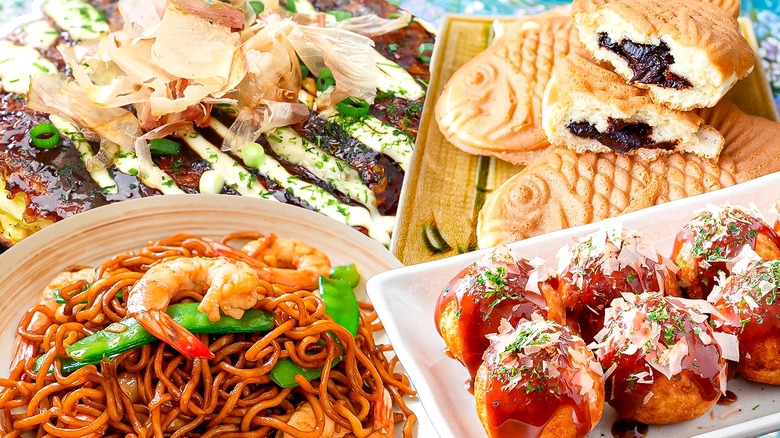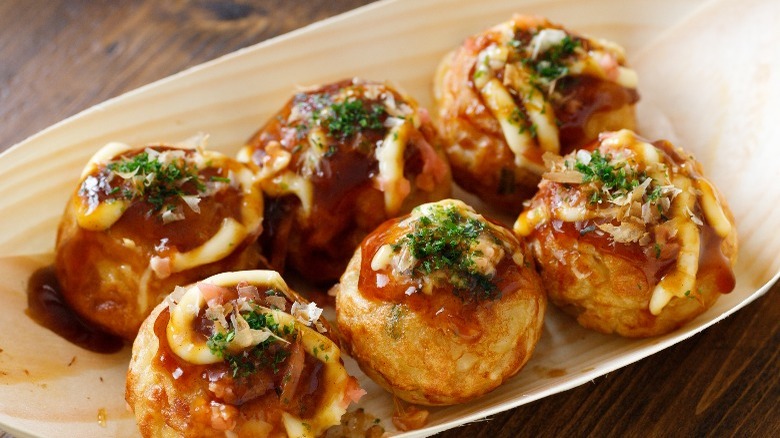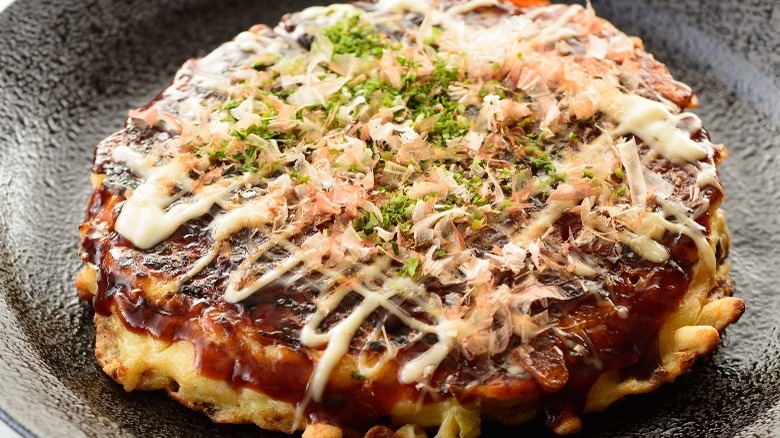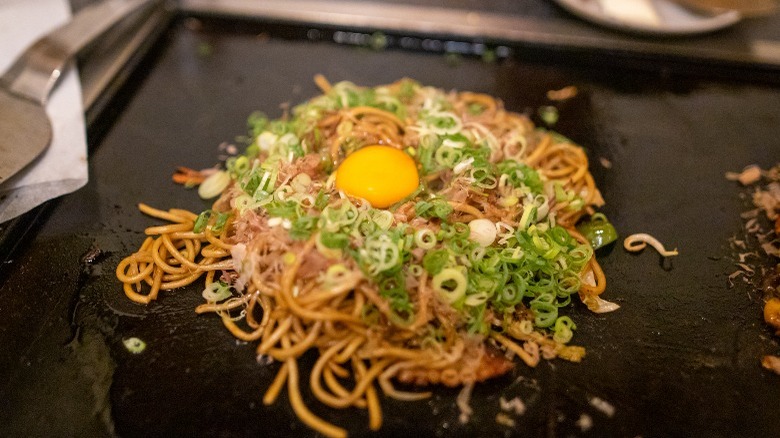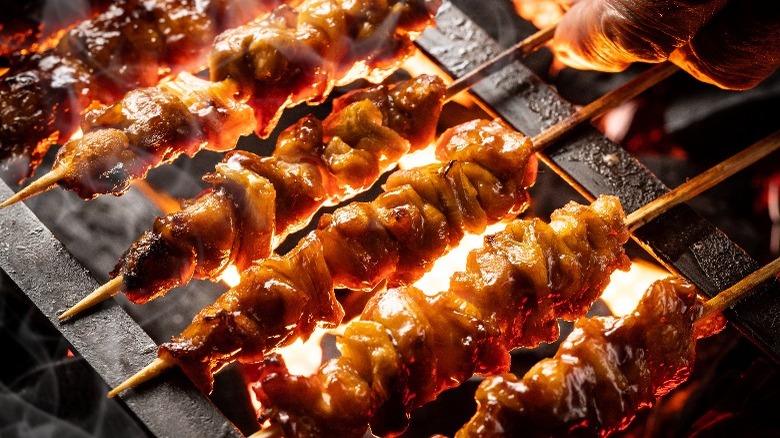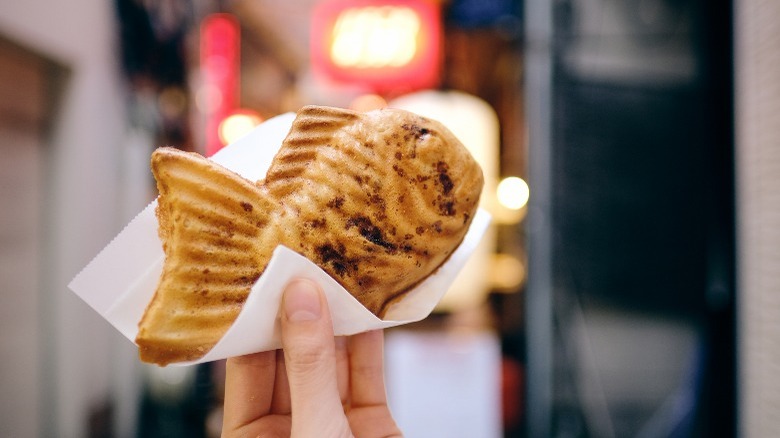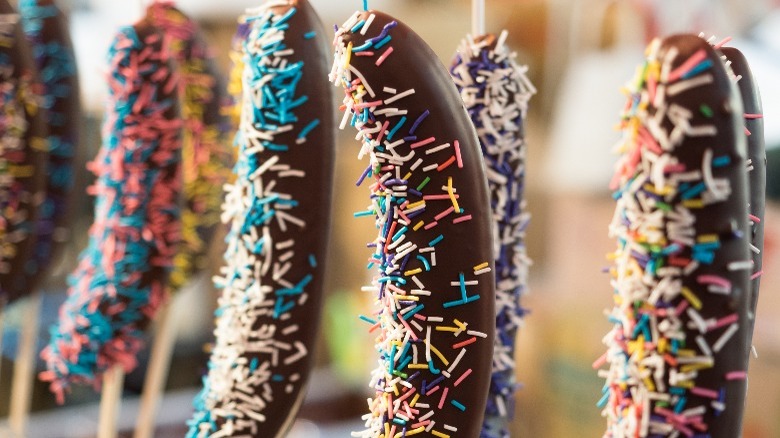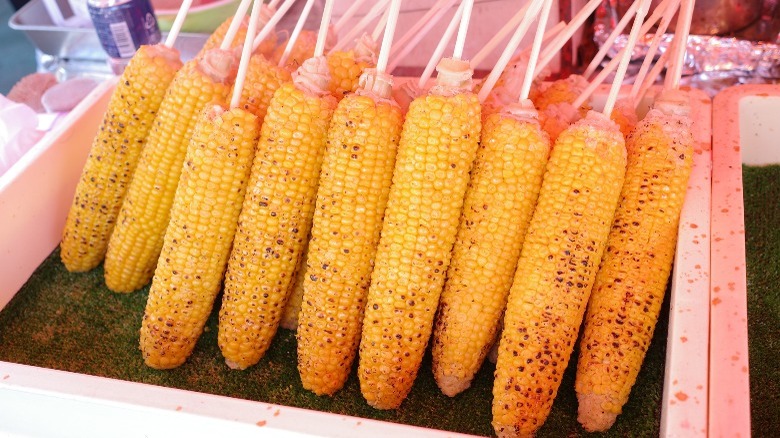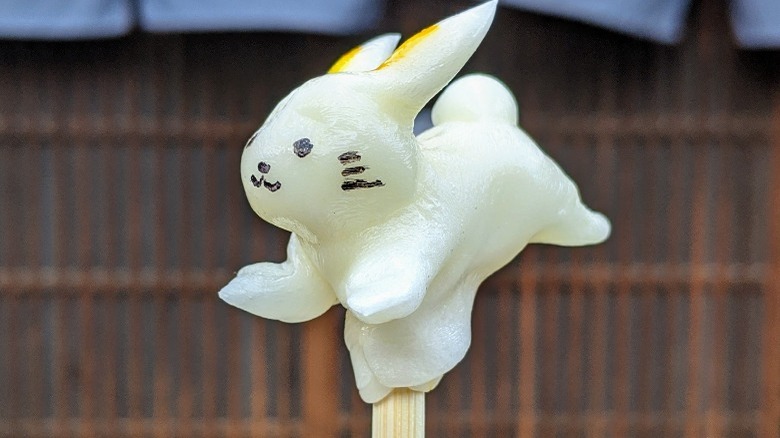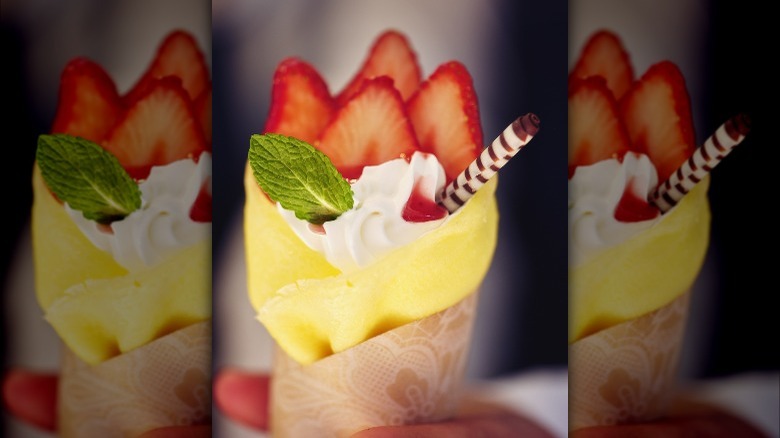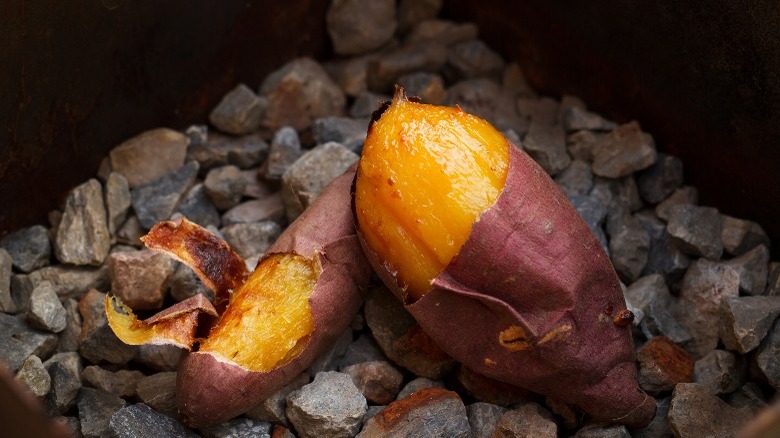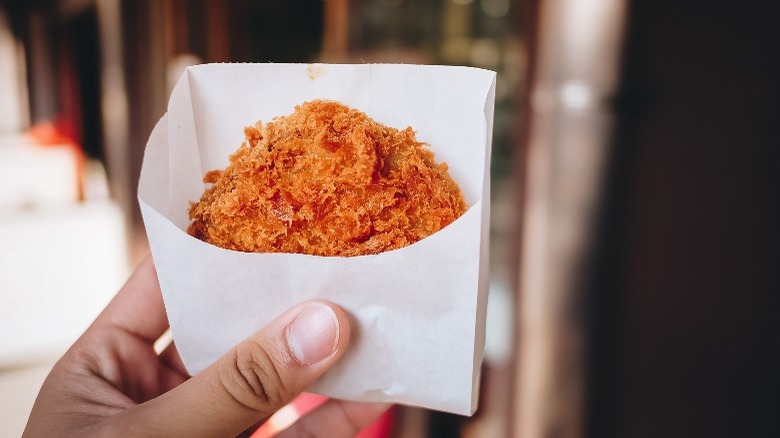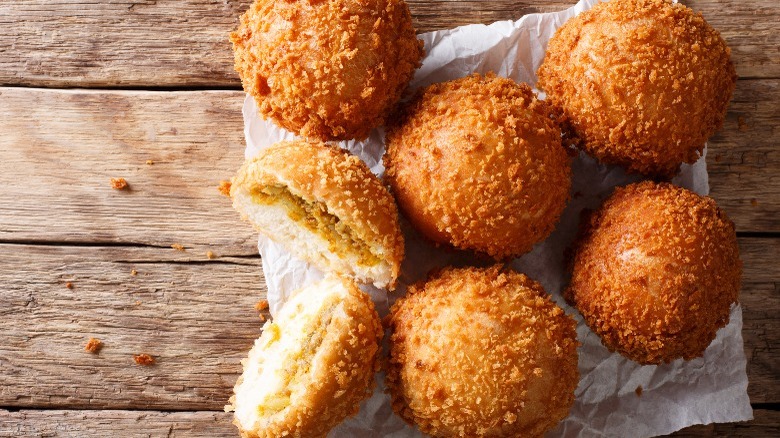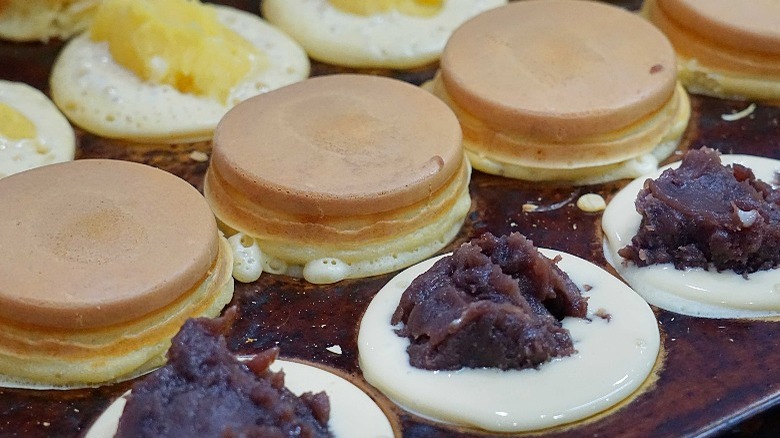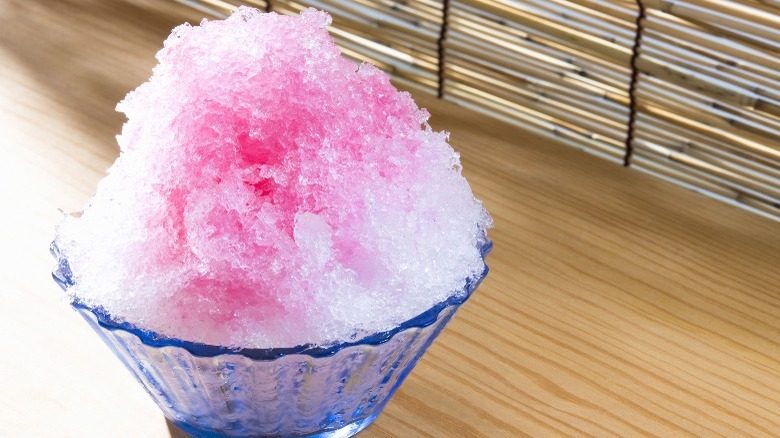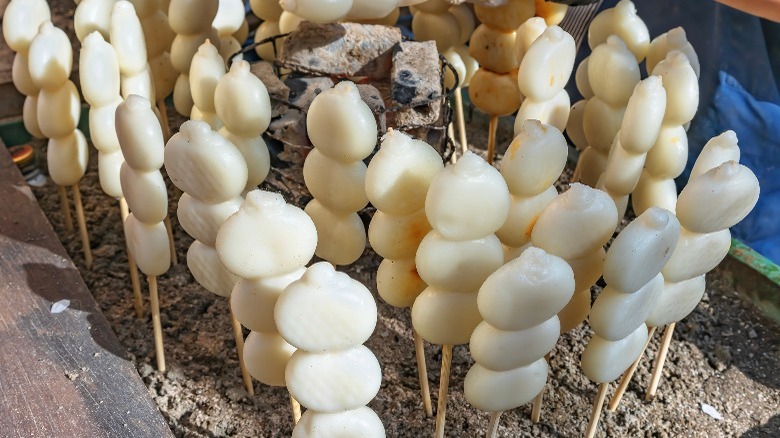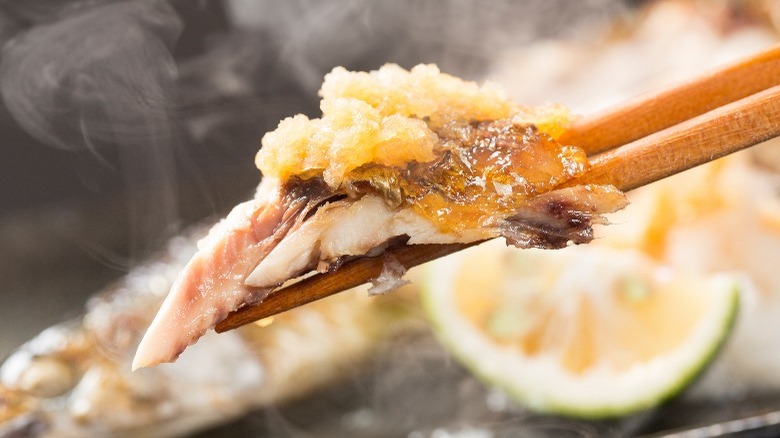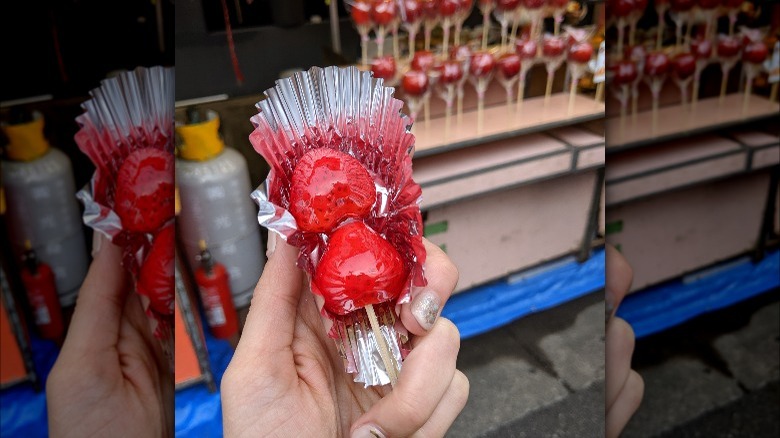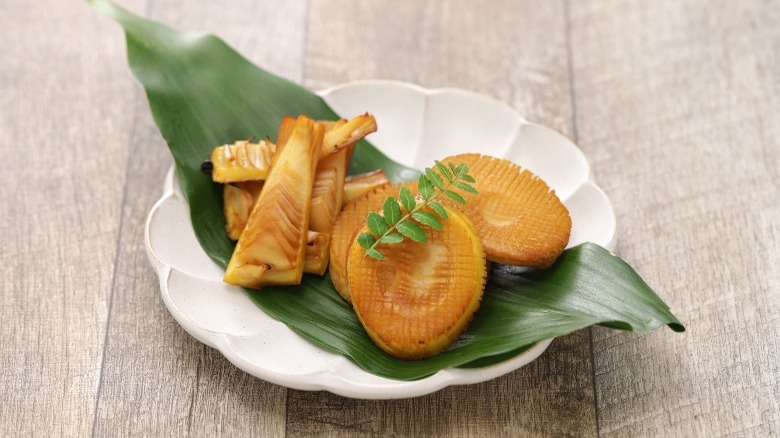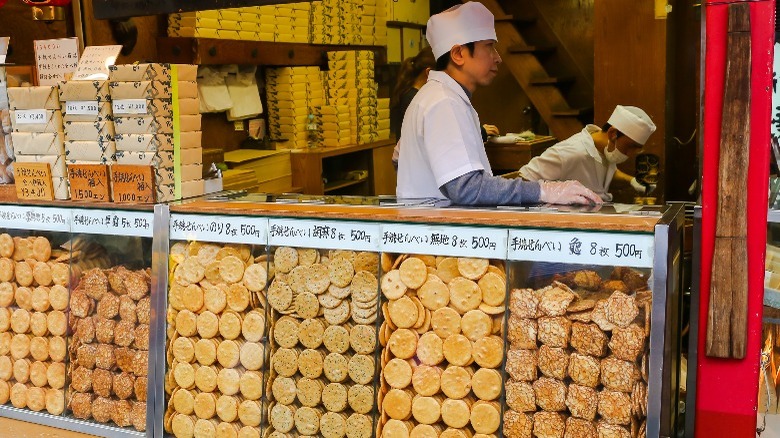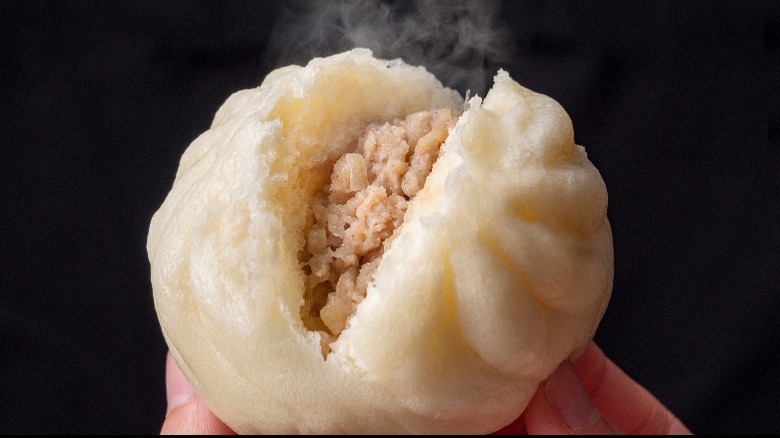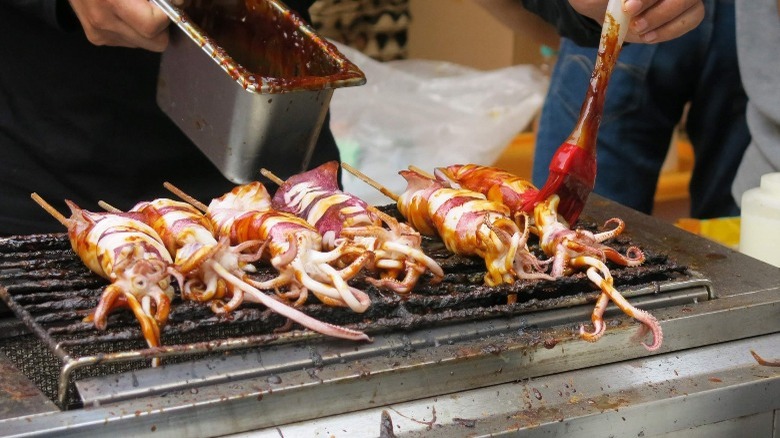21 Street Foods You Must Try When Visiting Japan
Yatai, Japan's iconic wooden food carts that you'll find in almost every major city, are one of the highlights of any foodie trip to the country. These quaint structures have been around for a long time, dating back to the Edo Period (1603-1868) when they were the fast food of the age, serving up afternoon snacks and evening meals to busy patrons.
Today they're as popular as ever, often setting up in the morning and staying open until late at night. A great spot to grab a snack on the go, refuel with a hearty bowl of ramen, or simply try out some of the street food delights Japan is known for, yatai usually serve up traditional Japanese dishes. Exploring their offerings is a fantastic — and affordable — introduction to Japanese food.
Whether you're heading for Nakasu in Fukuoka, the yatai of Osaka's Tennoji district, or even Kyoto's Nishiki Market, you'll find everything from noodles to deep-fried delights and sweet treats on offer at Japan's street food stalls. To help you get started, we're taking a look at 21 street foods you must try on your next Japan trip.
1. Takoyaki
First up is takoyaki, an Osaka specialty. In Japanese, tako means "octopus," while yaki means "to fry or grill." Early versions of these little deep-fried octopus balls were actually flat, and the dish is said to have been invented by Osaka street vendor Tomekichi Endo in 1935. Since then, takoyaki have evolved, and nowadays, they're generally served as ball-shaped fritters.
Filled with diced octopus, spring onion, and ginger, takoyaki are coated in a light, crispy batter and deep fried. You'll usually find them served with seaweed, sliced and dried bonito, and takoyaki sauce, a Japanese sauce made from Worcestershire sauce, mentsuyu — a Japanese noodle soup base — ketchup, and sugar. They're often drizzled with mayo before serving, too.
Fresh takoyaki taste nothing like the frozen versions you'll find on sale in many konbini. They're a delicious treat that's absolutely not to be missed on your next trip to Japan!
2. Okonomiyaki
Next up is another Osaka specialty that's become popular throughout Japan. Okonomiyaki is a light, fluffy Japanese savory pancake. Okonomi means "what you like," and yaki means "grilled" — the dish's name is often translated into English as "as-you-like-it pancake." This makes okonomiyaki incredibly versatile, as you can swap out the ingredients for whatever you fancy.
Traditionally, okonomiyaki is always made with a light batter containing flour, eggs, and mashed yam — though baking powder can be used in place of yam. Cabbage is a staple ingredient, with the addition of seafood such as shrimp or octopus. You'll also find meat versions with thinly sliced pork or bacon.
One thing that never changes is the sauce. Okonomiyaki sauce is sweet, sticky, and fruity, almost like a Japanese BBQ sauce. It's served drizzled over the pancake, which is then topped with Kewpie mayo. It's also traditional to top okonomiyaki with katsuobushi, dried bonito flakes.
The best thing about okonomiyaki? It's easy to recreate at home once you're back from your trip, with whatever ingredients you have on hand.
3. Yakisoba
Yakisoba, literally, fried noodles, is a stir-fry dish that's popular across Japan. You'll find Yakisoba served differently depending on the region you're in.
Traditionally, pork meat is used, though it's not uncommon to see other meats too. The fried pork is combined with finely-chopped cabbage, plenty of spring onions, and yakisoba noodles. Carrots, mushrooms, and beansprouts are often added too.
Despite the name, the noodles used in this dish aren't soba noodles but are instead made from wheat. Yakisoba noodles are usually sold fresh or frozen, lightly steamed, and coated in oil. Yakisoba sauce is made from Worcestershire sauce, ketchup, sugar, oyster sauce, and soy sauce. It can be adjusted to make it more salty or sweet, depending on preferences — and depending on which part of Japan you're visiting.
4. Yakitori
In Japanese, yaki means "grilled," while tori means "chicken" — and yakitori is one of the most popular Japanese street foods that's spread all around the world. These skewered chunks of chicken are grilled over charcoal. Many yatai and yakitori bars in Japan use binchotan, a special white charcoal made from oak that has no odor at all, allowing the flavors of the food to shine.
As well as grilled chicken, you'll also find yaki-ton, grilled pork, and sometimes a grilled beef version, or even shika (venison). Yakitori is traditionally served with tare, a sauce made from soy sauce and mirin for a salty, sweet, flavor.
The key to excellent yakitori is knowing how long to cook the meat for, using juicy meat (such as chicken thighs, which have more fat, and, therefore, more flavor), and grilling over high-quality charcoal. Though it's a simple street food, yakitori is a must-try whenever you're in Japan.
5. Taiyaki
It's hard to pass any street corner in Japan without coming across a vendor selling taiyaki. These little fish-shaped cakes are a popular Japanese dessert that looks a bit like waffles, and they're absolutely delicious.
Taiyaki first appeared in the Kanda district of Tokyo in the Edo Period, sometime between 1603 and 1867. Later, they became a popular street food snack and spread around the country. Today, the most popular place in Japan that's renowned for its taiyaki is Nishiki Market in Kyoto.
Taiyaki come with many different fillings, the most popular being chocolate, custard, or red bean paste. Though they're generally fish-shaped, you will also find vendors selling similar cakes in a variety of different shapes.
Watching taiyaki being made is an art in itself, and something you absolutely must make time for on any trip to Japan. Vendors carefully spoon prepared sweet batter into their greased molds, fill them with a scoop of red bean paste, chocolate, or custard, and top with more batter. The resulting cake is as Instagrammable as it is delicious!
6. Choco Bananas
As well as traditional Japanese food, you'll find vendors in Japan selling more internationally influenced options. Of these treats, one of the best sweets to try is the choco banana. There's nothing complicated about this street food — it's simply a frozen banana dipped in melted chocolate and often decorated with colorful sprinkles.
While it's true that a choco banana may not be the healthiest snack around, it is simply delicious and often comes in various colors so you can take some great street food snaps for your Instagram. Choco bananas are most popular in the hot summer months when locals and visitors are on the hunt for something to help them cool down — and they're sure to sell out fast.
There are plenty of other sweet treats to enjoy in Japan, but no trip here is complete without sampling a choco banana. Just make sure you eat it while it's still cold!
7. Tomorokoshi
The beauty of most Japanese street food lies in its simplicity, and what could be simpler than tomorokoshi? It's simply grilled corn on the cob, dipped in shoyu (soy sauce) and sprinkled with salt.
The story goes that tomorokoshi has been prepared in this way for around 250 years. These days the corn used is sweeter than it was hundreds of years ago, which contrasts beautifully with the saltiness of the shoyu.
You'll find tomorokoshi at most street food markets and yatai across Japan, but Sapporo in Hokkaido is famous for its tomorokoshi. Head to Odori Park during the spring and summer months to find rows of street food stalls serving tomorokoshi with shoyu and salted butter.
8. Amezaiku
Amekaizu is one of the more traditional treats you must enjoy when visiting Japan. This Japanese hard candy comes in various shapes, from animals to flowers and popular anime or manga characters.
A small stick is dipped into heated syrup, then food coloring is added. The melted sugar is shaped into a lump before a small pair of scissors or tweezers is used to shape it into form. It's absolutely fascinating to watch these street vendors craft hot sugar into various intricate shapes, and sure to be a highlight of any Japan trip.
Amekaizu have been around for a long time. They date back to the Heian period when they were used as offerings for temples. In the past, they were made from starch, rather than sugar. We much prefer today's deliciously sweet versions! This is one sweet treat that you'll only find in Japan, so make sure to try it while you're visiting.
9. Crepes
Though you'll find crepes sold throughout Japan at fairs and street festivals, it's Tokyo's Harajuku neighborhood that's most famous for its crepe shops. The crepes you find here aren't like the ones you'll enjoy anywhere else in the world, though.
Crepes in Japan are very thin and made from wheat flour. They're usually served folded into a cone shape, wrapped in paper. They're stuffed with a variety of fillings such as custard, fruit, chocolate, or even ice cream. Most street vendors use brightly colored ingredients to ensure their crepes look appealing, making them an excellent street food to try if you're recording your foodie adventures on social media.
Savory crepes aren't really a thing in Japan, though many street vendors do get creative with their fillings and toppings. It's not unusual to find savory-sweet combos like salted caramel or bacon and syrup on offer.
10. Yaki Imo
Japan's yatai and street food markets aren't just popular in the summer months. There are plenty of reasons to enjoy Japanese street food in the cold winter months, too, like yaki imo.
These are sweet potatoes baked over a wood fire, and they're out of this world! In the past, trucks would drive around cities with a loudspeaker announcing "yaki imo!" to the neighborhood, the wooden stoves onboard emitting savory-scented clouds of smoke. For this reason, many Japanese people find a comforting sense of nostalgia from ordering this dish from street stalls.
Cooking sweet potatoes over a wood fire gives them a crispy skin, deliciously soft, sticky interior, and smoky flavor. You'll also find some stalls serving daigaku imo, deep-fried sweet potato with sweet syrup and sesame seeds. If you prefer savory street food, try jaga bata, a baked potato with its skin removed and smothered with salted butter.
11. Korokke
Another street food that's deliciously cozy and comfortable in the colder months is korokke, or Japan's version of potato croquette. The key to its deliciousness is the light, fluffy, crispy panko breadcrumb coating.
Inside, korokke are filled with meat, vegetables, or seafood. The croquette's soft, creamy filling is rolled in wheat flour, dipped in eggs, and then covered in panko before being deep-fried until golden brown. Classic korroke are filled with mashed potato, ground beef, and onion. Different regions of Japan will have their own filling variations, but the crispy, crunchiness of korokke remains the same no matter which part of the country you're visiting.
The only problem with this popular street food? You'll struggle to stop after just one. With so many fillings to choose from — and that light, crispy coating thanks to the panko — it's too easy to overindulge; but why not? After all, you're on holiday!
12. Kare Pan
While some Japanese street foods, like korokke or choco bananas, might seem familiar, there are others that are more unusual and most definitely unique to Japan. Kare Pan is one such street food, but once you've tried it, you won't be able to resist looking out for it every time you pass a street food vendor.
Kare Pan translates as curry bread, and let us tell you, it is delicious, even if you're not sure it sounds that way. It's basically a savory donut made from sweet, fried dough. The filling is a savory, mildly-spiced Japanese curry — not dissimilar to katsu sauce — that contrasts perfectly with the sweet dough. Trust us, Kare Pan is surprisingly tasty, and rather moreish too.
13. Imagawayaki
So you've tried taiyaki, given amezaiku a go, and even sampled a choco banana — what's next on Japan's menu of street food sweet treats? Imagawayaki. Though they resemble pancakes, imagawayaki are soft, bite-sized golden sponges made with eggs, flour, sugar, and water, and shaped into disks.
Imagawakyaki is thought to date back to the Edo period, taking their name from a bridge of the period in Tokyo where they are said to have first been sold. In the Kansai region of Japan, imagawakyaki are known as taiko-manju.
It's the fillings of these little sponges that make them memorable, though. You'll find imagawayaki have similar fillings to taiyaki, with red bean paste, custard, or chocolate being the most popular. It's fun to watch vendors skillfully prepare these bite-sized cakes — they seem to know exactly how much batter and filling are required to create perfectly-formed treats.
14. Kakigori
Depending on which region you visit, Japan can get pretty hot in the summer months, with average temperatures in Tokyo reaching a high of around 82 degrees Fahrenheit. Often it feels even hotter in big cities due to the sheer number of people around.
When the sun is beating down, locals and visitors enjoy kakigori, a shaved ice treat that's like a snow cone, but better. Kakigori dates back to the 11th century and even has its own day on July 25. Across major cities in Japan, you'll find specialty kakigori stores serving up every flavor you could think of, or you can buy them from street vendors.
You might be surprised to find that kakigori tastes creamier than you expected. That's because it's made with condensed milk, with flavored syrup and sweetener added. It's colorful, light, and refreshing, making it the perfect cooling treat for hot summer days.
15. Dango
You'll find street stalls selling dango everywhere you look in Japan. These little spherical dumplings are made from mochiko, rice flour, and topped with a glaze made from soy sauce and sugar. They're served on a skewer, and you'll usually get either three or five dumplings.
It's said that this treat originated at the Jamo Mitarashi Tea House in Kyoto, originally created as an offering for the gods. It wasn't long before street vendors in Kyoto caught onto dango's popularity and started selling them as a snack, and you'll often find them at festival food stalls.
Dango can be sweet or savory, and the sweetness varies. Pink, white, and green hanami dango has a light, sugary taste. For a more savory hit, ikinari dango is rich and gooey, made with roasted sweet potato.
16. Shioyaki
After something sweet, you might find yourself craving something authentically Japanese; something savory packed with umami, salty flavors. Why not give shioyaki a go?
Shioyaki literally means "grilled with salt." This salty baked fish, usually mackerel but sometimes salmon, is served on a stick.
In Japan, shioyaki is a popular breakfast dish, but you can enjoy this salty fish at any time of day. As well as grilled salted mackerel, you'll find tai no shioyaki, salt-grilled sea bream, as another popular choice, traditionally served at New Year's.
Because the salty, smoky grilled flavor of shioyaki is quite intense, you might want to follow it up with something sweet or refreshing in contrast. A dessert like taiyaki or imagawayaki would be a good choice — or kakigori in the summer months.
17. Candied Fruit
Candied fruit is a street food that's popular across Japan, and comes in many variations. If you're in the country during strawberry season, from December to May, you absolutely must try ichigo ame, candied strawberries. You could even go strawberry picking near Tokyo, as there's nothing quite like fresh Japanese strawberries.
As well as candied strawberries, you'll find ringo ame, candied apples, anzu ame, candied apricot, and the rare mika ame, which uses a mandarin native to Japan that you're unlikely to find anywhere else. The fresh fruit is dipped in candy syrup before being skewered and left to harden. The resulting confectionery is exceptionally pretty and tastes as good as it looks.
18. Yaki Takenoko
During the spring and summer months, from March until around May, fresh bamboo shoots are in season. Yaki takenoko is one of the highlights of a trip to Japan at this time of year, and if you stumble across a street food vendor selling them, you simply must give them a go.
The fresh bamboo shoots are marinated, skewered, and grilled over charcoal. Bamboo's naturally sharp, bitter flavor takes on a rich smokiness from the charcoal, the perfect match for a simple shoyu-based tare sauce that brings out the fresh flavor of the bamboo.
As well as yaki takenodo, you'll also find a range of other dishes containing bamboo shoots when they're in season. Tosa-ni, or simmered bamboo shoots, are absolutely delicious, cooked slowly in an umami-packed broth made from soy sauce and katsuobushi (dried bonito). Takenoko gohan, or bamboo shoot rice, is another popular dish. Cooking the fresh bamboo shoots with the rice imparts fragrant, earthy notes that make this dish a must-try.
19. Senbei
Senbei, sometimes called sembai, are rice crackers with a glazed topping. These crackers are sold across Japan in many different flavors that vary depending on the region. While you can buy pre-packaged senbei in grocery stores or specialist shops, there's nothing quite like the ones prepared at street food stalls.
Senbei are one of the oldest Japanese snacks, with the word first being mentioned around 737. Kansai senbei are lighter in flavor and density than kanto senbei. When you buy senbei from street food stalls, they're usually cooked over a charcoal grill which imparts a delicious smoky flavor.
While senbei are usually savory, you can also find sweet and candied varieties. They also come in a range of different colors, either colored naturally by the type of rice used, or with dyes added, usually to celebrate various festivities. Traditionally senbei are enjoyed with green tea, and common flavors include seaweed, negi (spring onion), and miso.
20. Nikuman
If you've enjoyed Chinese bao (steamed buns) before, then prepare to step things up a level with nikuman. This Japanese take on the steamed bun features pillowy soft dough packed with a savory, juicy pork filling. The "niku" part of the name refers to meat, but different vendors will offer a range of fillings.
Nikuman are one of the most popular street foods in Japan during the winter season as they're so warming and filling. In the past, they were once called chukaman (Chinese-style steamed bun) and sold at specialty shops across Chinatown. Later, they became more widely sold to the Japanese public around 1927.
You can't really go wrong with nikuman, as the classic combination of a steamed, hot fluffy bun and a rich ground meat filling is hard to beat. Make sure to try out some of the other fillings on offer while you're in Japan, though.
21. Ikayaki
The final item in our roundup of street food you must try in Japan is one of the simplest and most delicious dishes around. Ikayaki is skewered grilled squid topped with a soy sauce-based marinade.
Don't be daunted by the appearance of this popular street food, as it's absolutely delicious. The fresh flavor and delightfully chewy, plump, tender texture of perfectly prepared ikayaki can't be beaten. The soy sauce topping adds rich, salty flavor that pairs perfectly with the fresh seafood.
Ikayaki is prepared and served differently depending on which region of Japan you visit. Osaka-style ikayaki, fried squid with egg in a soft pancake, was the result of a happy accident when Saitou Yoshika, the owner of Yakiya Kaiyukan, a store in the city's Momodani district, wanted to create a dish similar to okonomiyaki but using squid. Combining squid and eggs in a pan with a dashi-based broth, Osaka-style ikayaki was born.
